One of the great things about my subscription to everything Microcosm Publishing publishes is that I get a regular delivery of books I simply wouldn’t find my way to otherwise.

The number of drive in movie theatres on PEI has doubled with the arrival of The Runway Drive In in Summerside.
It is, quite literally, almost right on the runway at Slemon Park (née CFB Summerside). The programming appears to be a mixture of films new and old: this weekend it will be Footloose, Grease, and The Secrets We Keep.
I still haven’t quite gotten over the closure of the Princess Pat Drive In in Cascumpec, and it seemed unlikely that the Island would see another in the west. I hope they do well.
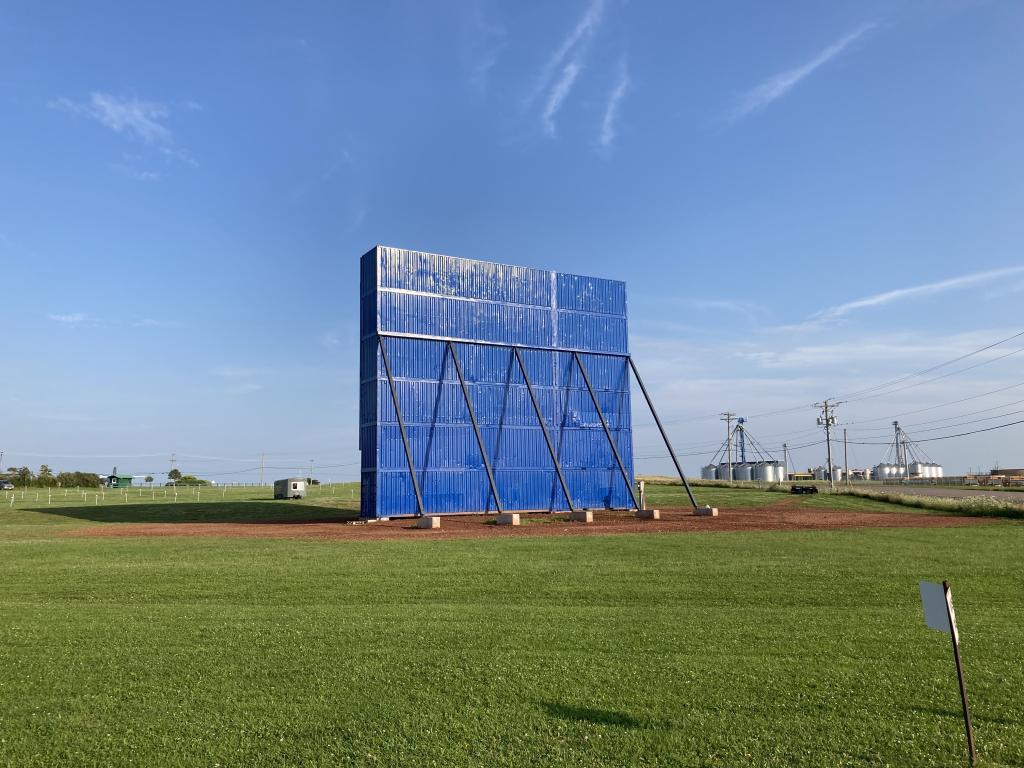
Thelma relates wise words from Steven:
This isn’t happening to you; it is just happening.
Those words helpfully encapsulate an ad hoc philosophy I came to organically. Of necessity.
They also are at the heart of what Scott Shute, Head of Mindfulness and Compassion at LinkedIn, espouses in an interview on the Good Life Project podcast. In part:
Yes, I’m Scott, I have these big dreams, and I’m going to do everything I possibly can to make those dreams come true, and… I gotta let it go. I gotta do the parts that I’m responsible for, and then if life wants to happen around me, or the universe wants to evolve around me, I don’t control any of that.
When you order a pour-over at The Shed, it’s served in a tiny perfect Brewista carafe.
Having sketched all the buildings I can see from the patio there, I turned my pen to sketch my coffee.
I’m still trying to grok sketching round openings at an angle, so the top is a little wonky, but there are other things about the way this turned out that I like.
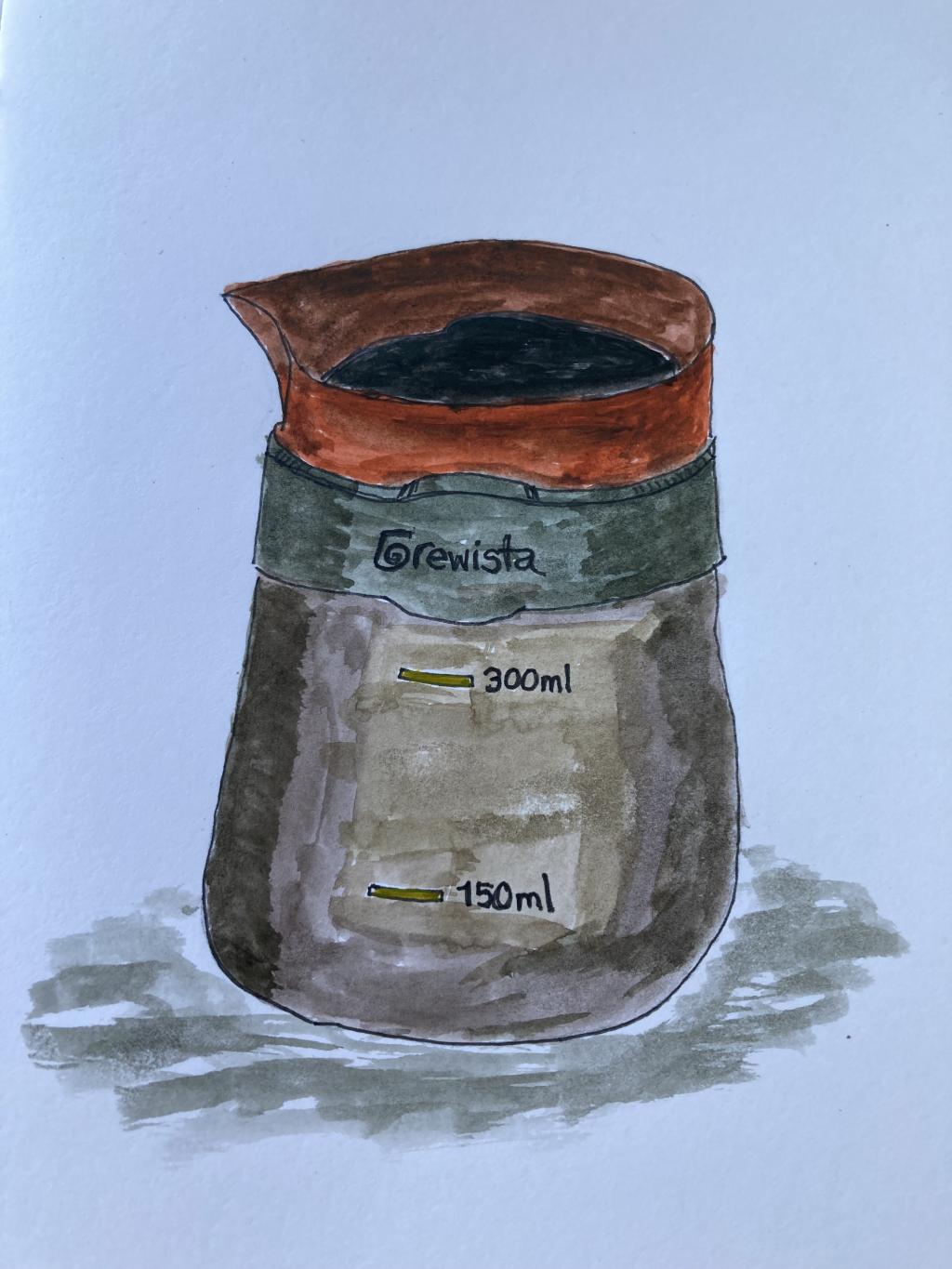
My friends—and neighbours, colleagues, landlords—at St. Paul’s Anglican Church tell the story of the intentional destruction of a bold statement of Pride: the “rainbow staircase” leading up into the Parish Hall was removed by vandals.
While this is egregious by any measure, it’s particularly egregious for me: there has been no more welcoming and supportive a community since Olivia came out as the St. Paul’s community. The love, support, and solidarity they’ve shown our family has been breathtaking.
Desecrating a powerful symbol of that solidarity is wounding: to Olivia, to me, to the faith community of St. Paul’s, to our neighbourhood, and to the larger 2SLGBTQI+ community. To all of us.
“We pray that whoever did this will open their heart and see God’s love everywhere,” the church wrote; it’s difficult to find such equanimity when faced with a threat that strikes so viscerally.
It was a beautiful afternoon: sunny, warm, and only 4 knots of wind (see, I’m a seafarer now!). I didn’t have it in me to cycle out to Andrews Pond with my canoe, but I did fancy a paddle over lunch.
I remembered that the Charlottetown Yacht Club had an arrangement with the City of Charlottetown to provide a public kayak launch, and a quick check with them confirmed it’s still there, and that canoes are as welcome as kayaks.
So I suited up and headed down Prince Street and along Water Street with my canoe behind me.
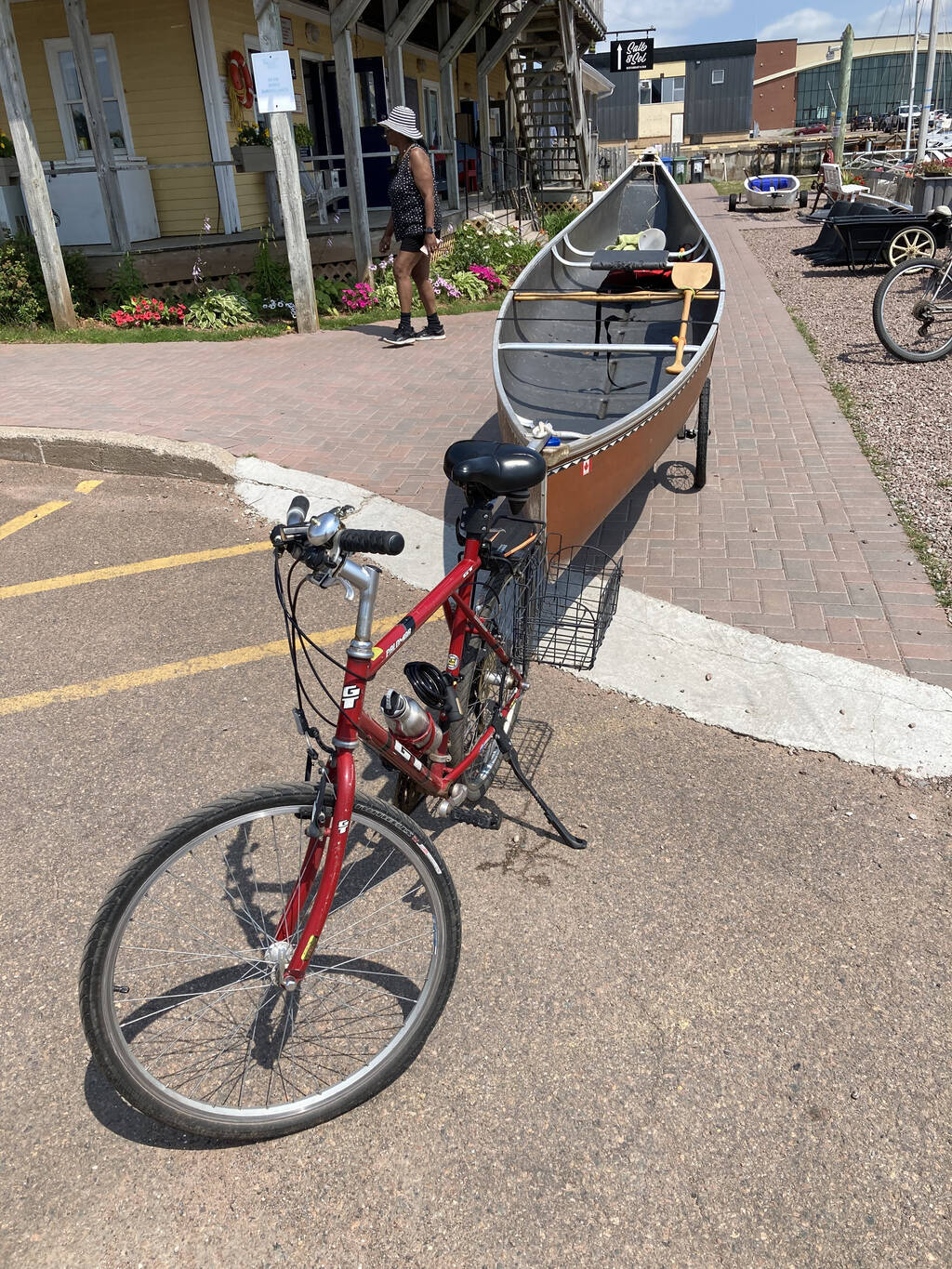
I was nervous enough on the turf of the yachty milieu that I neglected to take any photos of the launch itself, which is a rather ingenious contraption involving chute-and-rollers. I was able to roll the canoe down the ramp to the launch still on its trailer and then slide it onto the chute. Once I’d stashed the trailer back on land it was easy to hop into the canoe and slide it into the water.
Even though the wind was light, I decided to stay in the protected confines of the Yacht Club’s marina rather than venturing out into open water; I paddled in and around the various yachts, modest and otherwise.
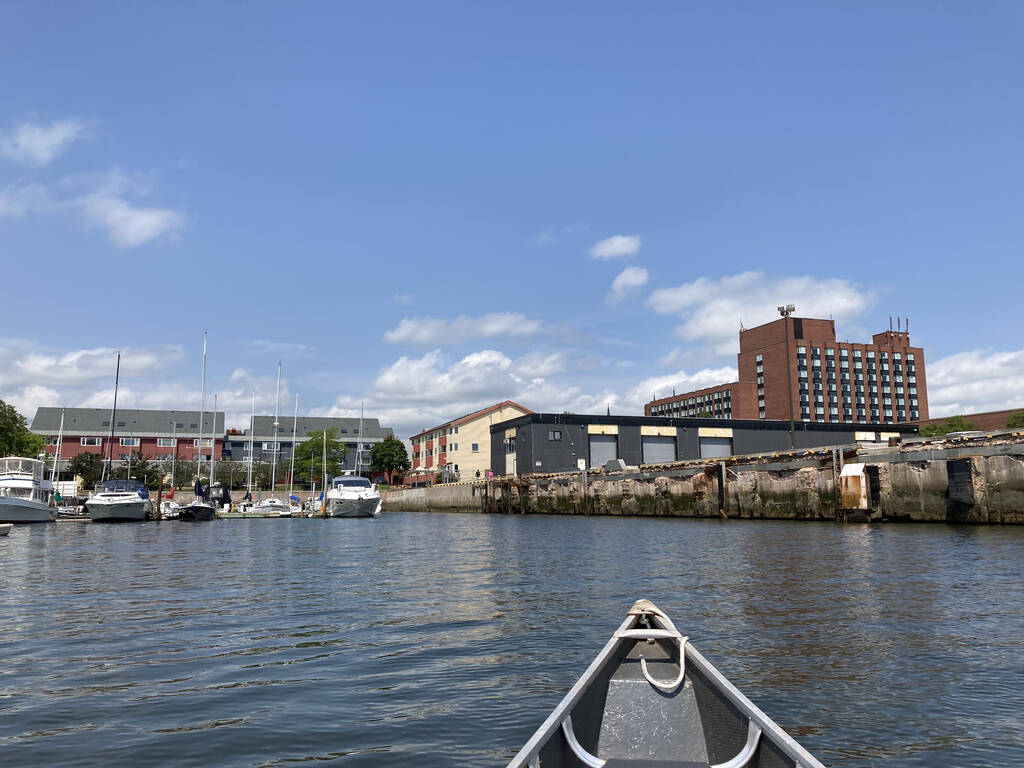
The decaying Coast Guard Wharf, which abuts the Yacht Club, is an interesting piece of art (at least until it falls into the ocean):
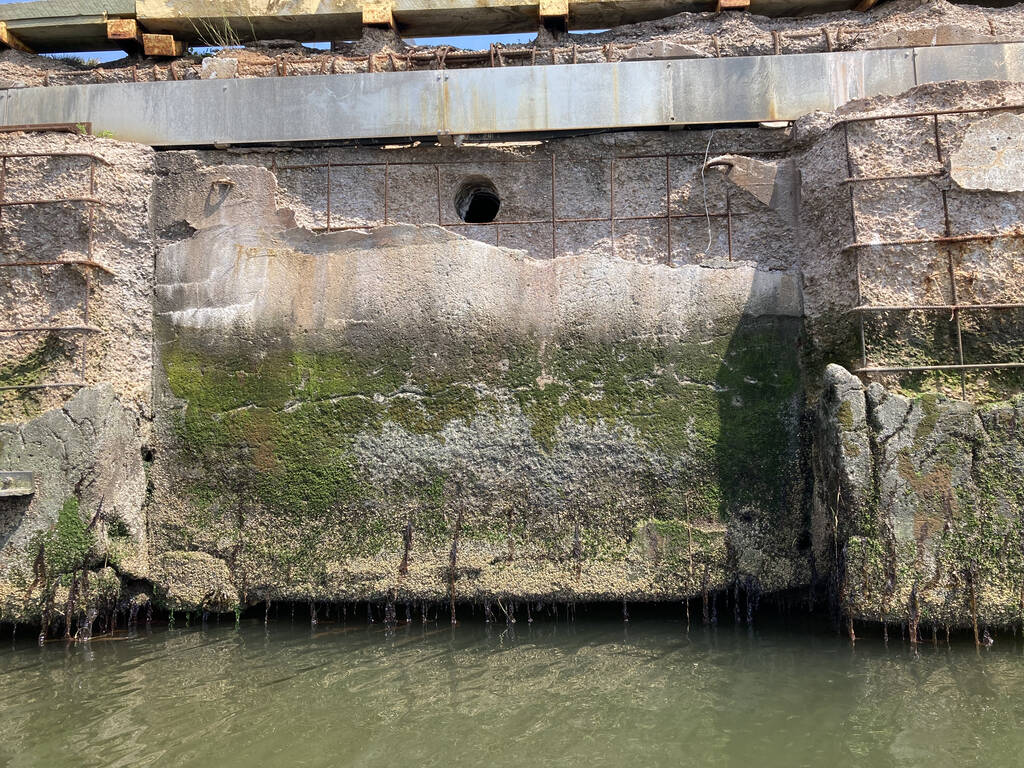
I didn’t stay in the water for long, just a taste, really: I noticed that the wooden strut that runs across the centre of the canoe had, like the seats before it that I had repaired, rusted out to the point of failure:
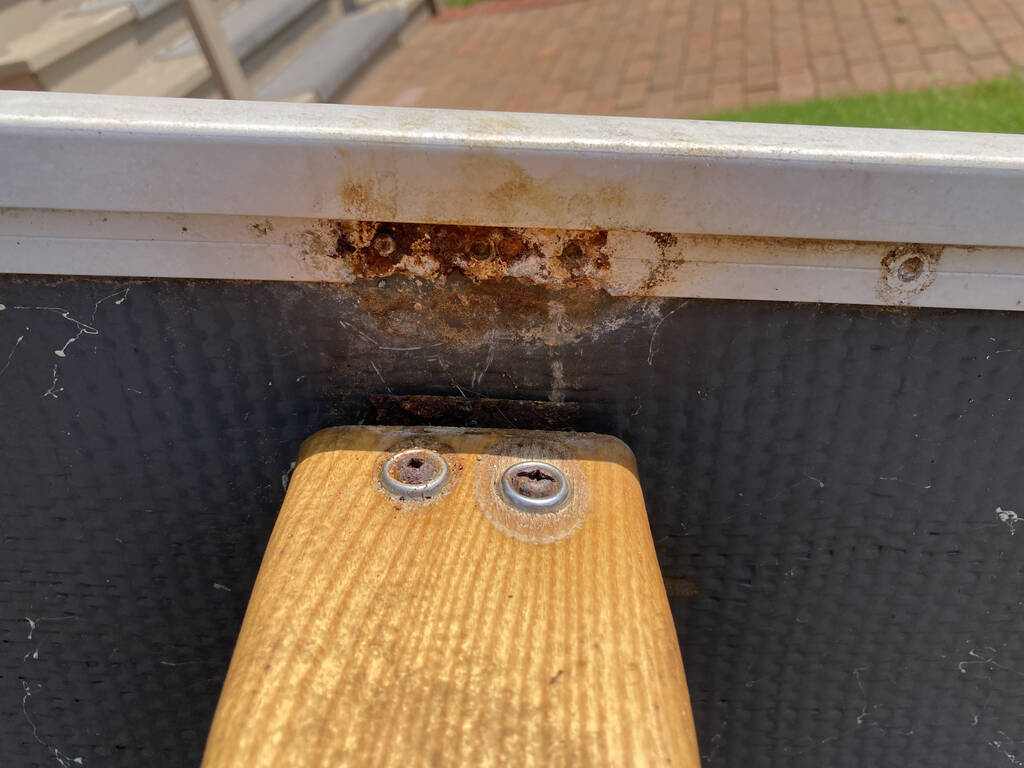
While I was in no immediate danger of canoe-collapse–the strut is primarily there as a yoke for portages–I decided not to tempt fates, and so returned to the launch, propelled myself up the chute-and-rollers by taking a good run at it, and loaded my canoe back on its trailer. I gave it a quick rinse at the top of the ramp (a nice feature of the launch, given the salt water), and I was off again home. Door to door for a lunchtime paddle–with time out for a falafel at the Salt and Sol–was 90 minutes.
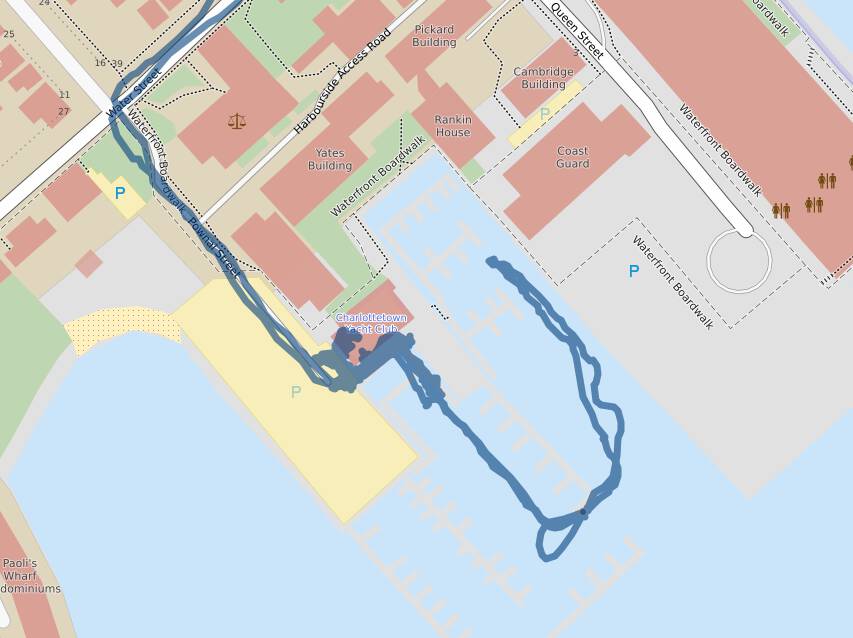
My summer project to resurrect my old canoe, strap it to my bicycle, and explore Charlottetown’s waterways, finally bore fruit on Sunday: I cycled out to Andrews Pond, put the canoe in the water, and went for a paddle. A paddle that ultimately took me under St. Peters Road.
Getting There
I left home, with my canoe behind me on its Wicycle trailer, and headed out Grafton Street to the Riverside Drive Cycle Path. I’d checked the weather before leaving and found the wind reported to be 19 km/h, which Siri interpreted as “not too windy,” so it seemed like I wouldn’t be blown off the road, and this proved true. I followed the path out to the Queen Elizabeth Hospital, then crossed over to the new section that runs out to St. Peters Road. Although this was slightly up-hill, I didn’t find the going too hard, and, as I remembered to make r-e-a-l-l-y w-i-d-e t-u-r-n-s, I didn’t hit anything.

The final stretch, from Kensington Road to St. Peters Road, was somewhat more up-hill, and while I managed to stay on my bicycle for the entire trip, I was pushed to the edge of what I’m physically capable of, and had to stop a few times to take a drink (it’s amazing what a healing elixir water becomes in a situation like this).
At the St. Peters Road megasection, I turned right, and then at the roundabout I crossed over to the far side of the road and took the new AT path along the west side of the road and down into the Wright’s Creek Watershed.
The instructions on the Watershed website for launching a boat are as follows:
Park beside the mailbox beside 66 Herbert Street. There are two parking spots off the street to the right of the mailbox. Carry your boat 50 meters down to the dock.
These are car-focused instructions, so I had to wing it: I rode my bike along the southern shore of Andrews Pond North, threading the canoe surgically through trees that seemed perilously close together–and found my way around to the specified launch site on the north shore of Andrews Pond North.
Putting In
The canoe put-in is a modest dock with a canoe-sized place to slide a canoe into the water:
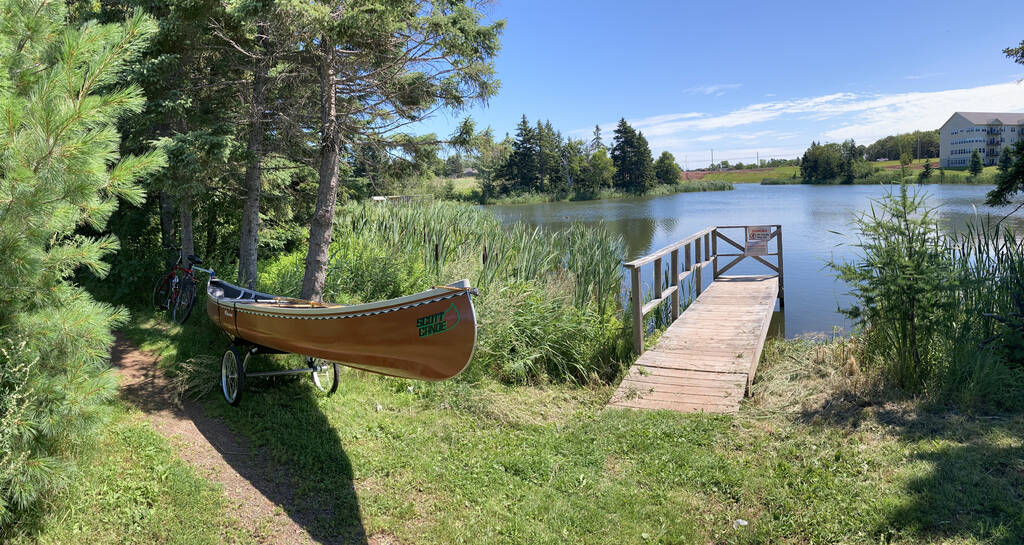
I unshackled the trailer from my bike, rolled the canoe over to the water still on its trailer, removed the trailer, and the canoe slid, like butter, into the water. It was much, much easier than I thought it was going to be. I locked up my bike, put on my lifejacket, grabbed my paddle, and, with more than a few butterflies in my stomach, shimmied my way into the water.
I was afloat!
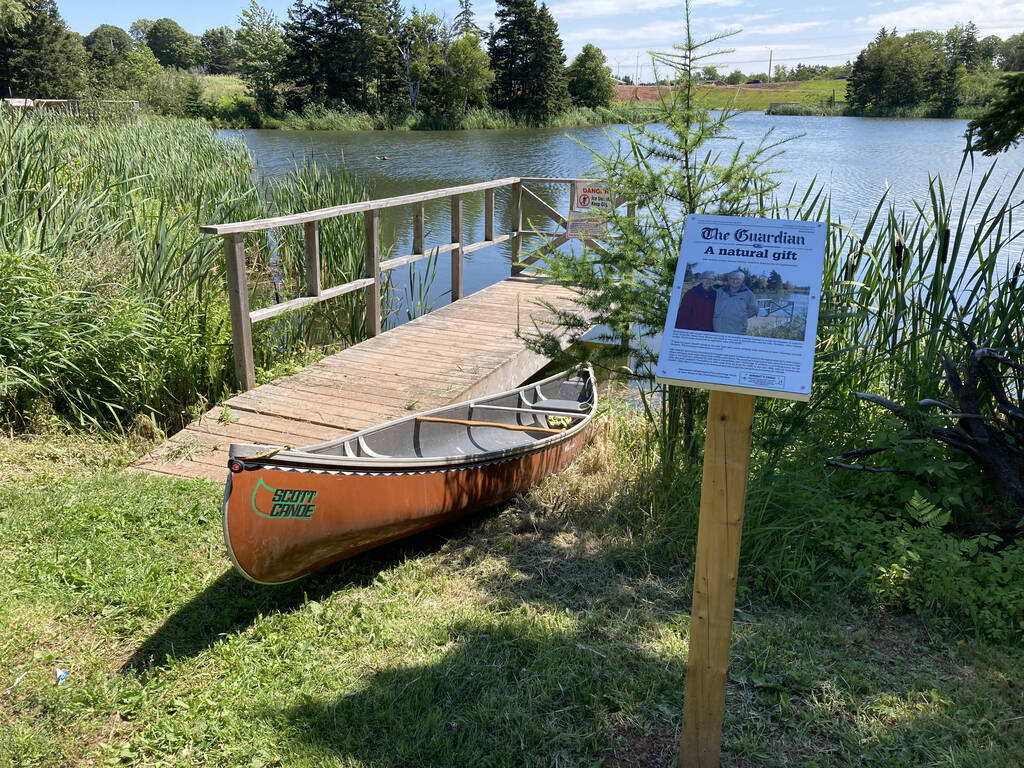
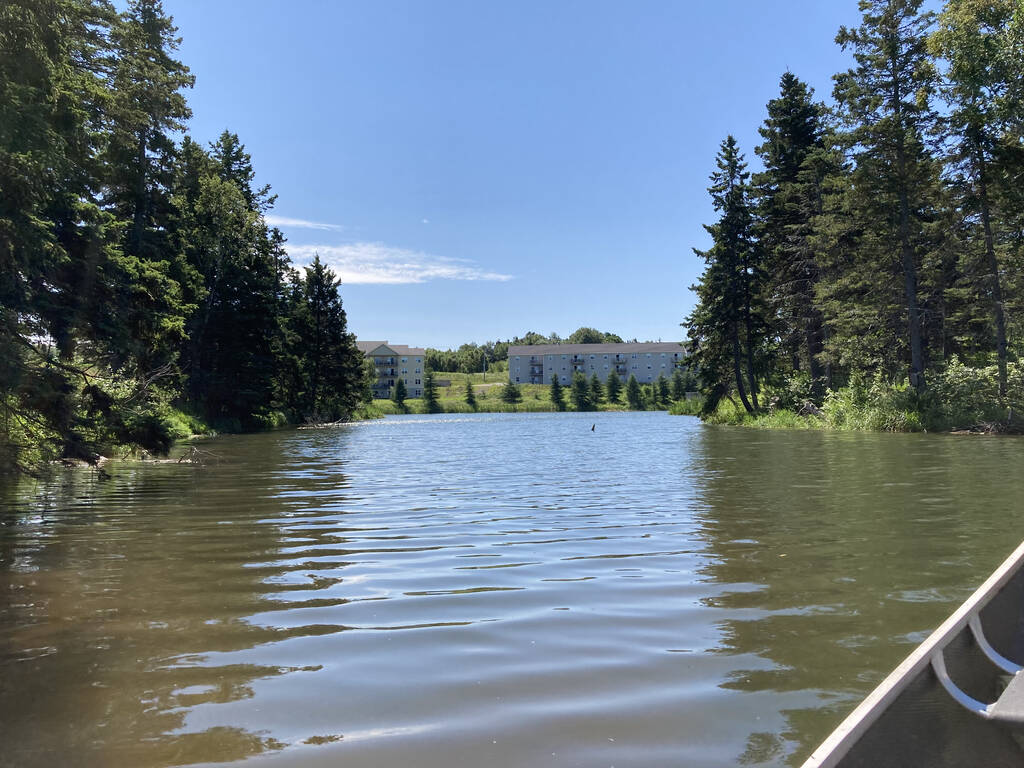
Paddling
After watching a lot of YouTube videos about paddling a double-canoe solo, I found that the consensus was that I should sit or kneel in the bow seat, with the canoe facing “backwards,” the stern pointing forward. This proved good advice: in this position I found the canoe was stable, the bow (er, stern) wasn’t sticking up into the air, and, give or take, I could control the canoe without too much trouble.
I was happy to find that my summer camp canoe training came flooding back to me: J-stroke, C-stroke, feathering and the like.
Andrews Pond is bisected into North and South sections by St. Peters Road, and the North section, where I put in, has a longer fetch (yes, Mr. Campbell, I was paying attention in grade 11 geography); while it was by no means open-ocean like, the wind moved the canoe around a little more than in the South section. Nothing dramatic, but also not On Golden Pond-still.
East Royalty, the neighbourhood that surrounds Andrews Pond, has seen intensive development over the past decade, meaning that lovely vistas of cormorants sitting on a log have a background of apartment buildings. It’s nature, yes, but at the interesting place where nature hits human settlement.
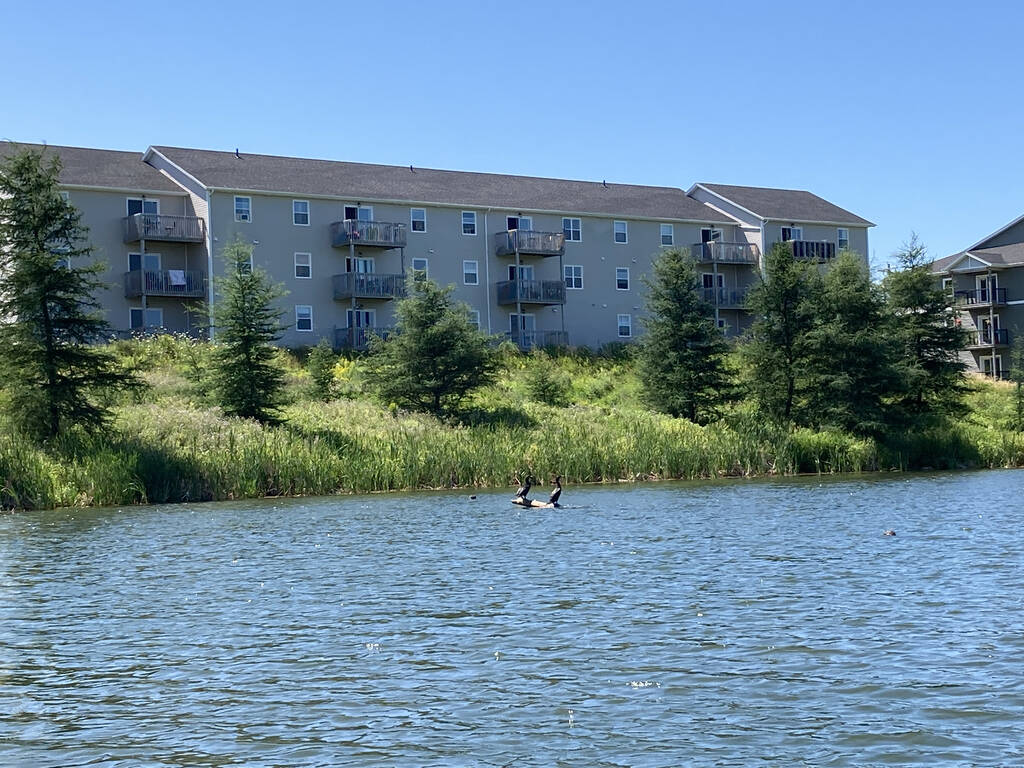
Under the Road
Another aspect of human development in the neighbourhood, closely linked to the building boom, is the transformation of St. Peters Road from Riverside out to the edge of the city: what was until recent years a modest two-lane road is being transformed into a multi-roundabout thoroughfare. Part of this plan involved constructing a roundabout on the causeway that bisects Andrews North from Andrews South, and, part of that roundabout plan involved building both pedestrian and watercraft tunnels under the roadway:
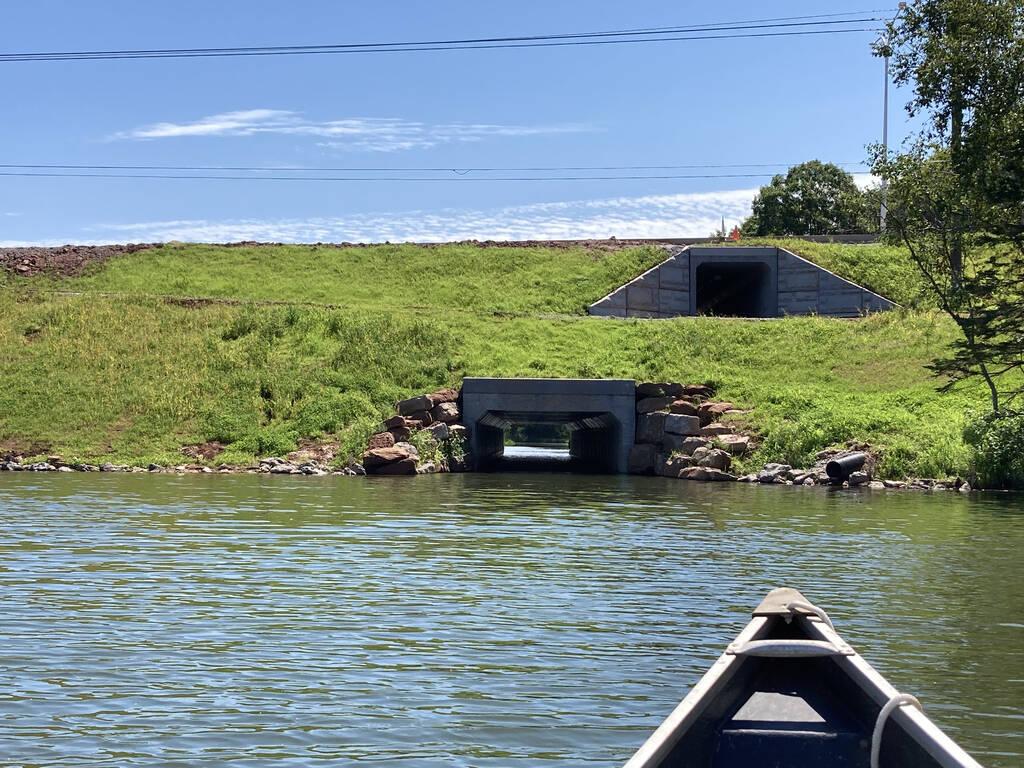
I’m not sure what the impetus for these tunnels was, but I don’t begrudge them, as they unite the two sides of the pond logistically, and make the Wright’s Creek Watershed navigable without crossing the highway. It also happens to be a fun little bit of exotic terrain for the canoeist:
Andrews Pond South
As I wrote above, Andrews Pond South, with a shorter fetch and more embracing forest surrounding, was a much calmer place to paddle. You can see the difference simply from the glassiness of the water by comparison:

It was a delight to paddle about the south end: with less wind, I didn’t need to worry so much about getting blown to shore, and could focus a little more on getting comfortable in the canoe, experimenting with sitting, kneeling, leaning. I saw adolescent ducks paddling about, caught a glimpse of the eponymous Andrews homestead, and, hearing the rush of the dam at the end of the pond, decided to turn back before I got too close (I’m not sure to what degree the dam is a danger to approaching watercraft, but I decided not to try to find out).
I headed back through the tunnel (as much fun the second time as the first!):
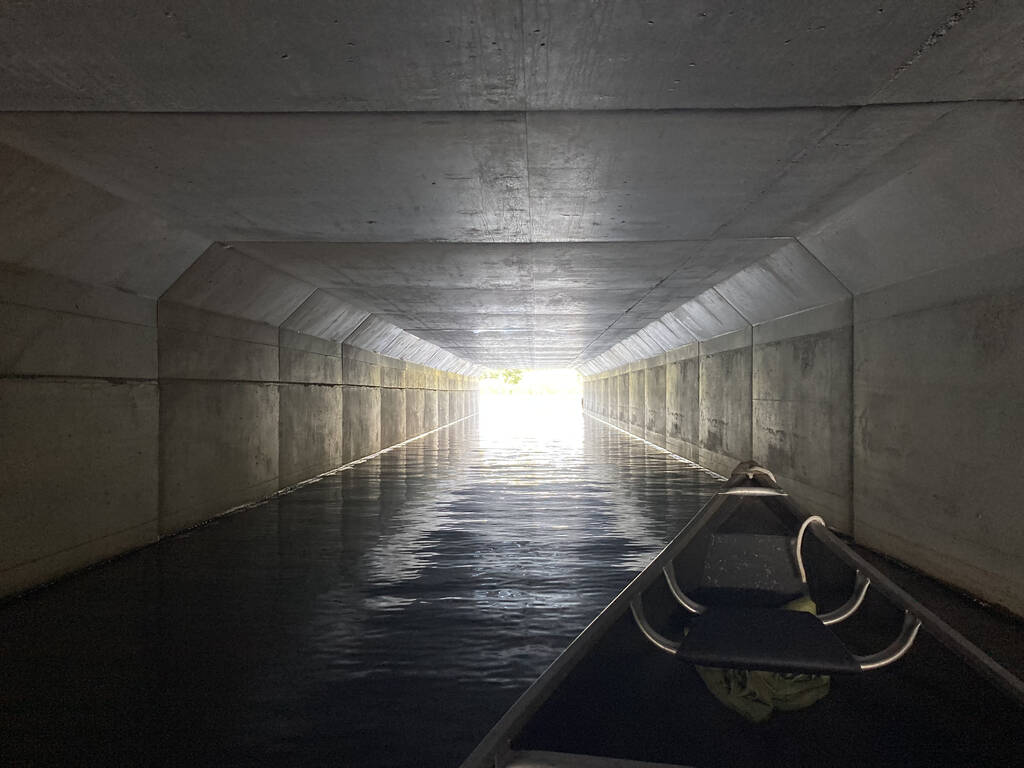
When I got through to the other side I was immediately faced with the challenges of paddling solo straight into the wind: the bow kept getting caught by the wind and whipped around; ultimately I “solved” this problem by paddling backwards (another skill I recall from summer camp), which must have presented an odd vista to any onlookers from the overlooking apartments, but got the job done.
Ashore
It was a little trickier getting back ashore than it was putting in, mostly due the aforementioned wind, but I managed. The canoe slid into a comfortable berth enough for me to hop out onto the dock:

While hauling the canoe out of the water and onto the grass was easy, getting the trailer centred underneath it proved challenging, and took several tries; the initial tries I ended up with it too far back, like this:
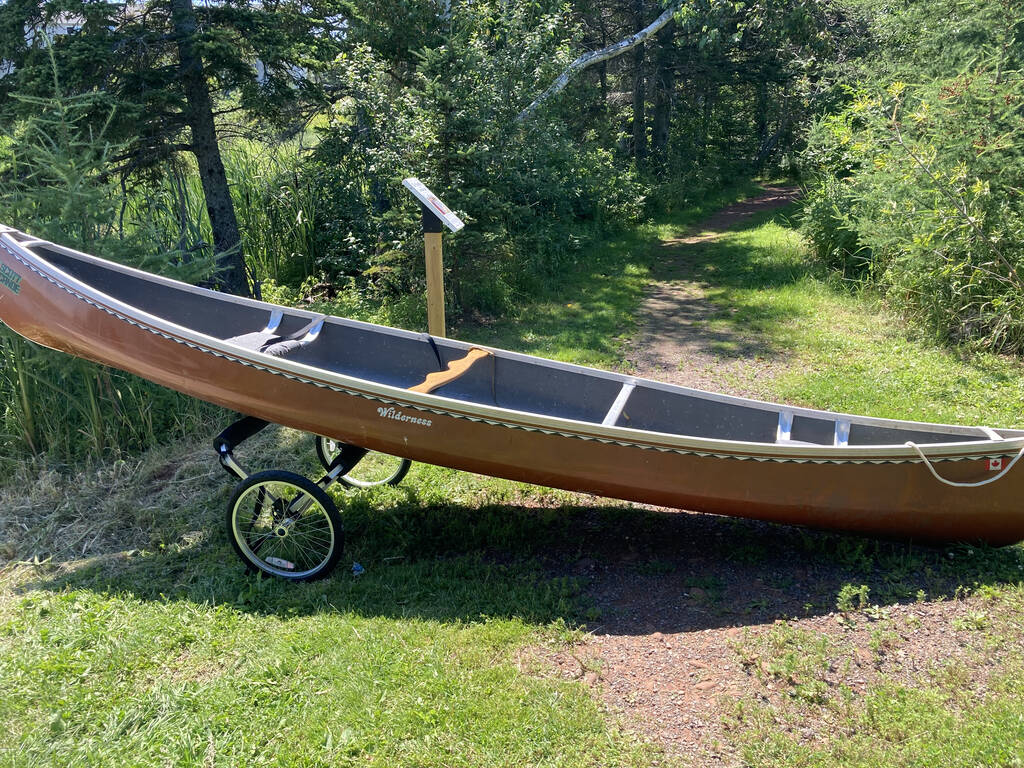
I kept at it, though, and eventually got it in the right place.
I lashed my paddle into the canoe with bungie cords, attached my bicycle, and re-attached the flashing red light to the stern, mindful of the trailer-related sections of the Highway Traffic Act (which don’t mention canoes being pulled by bicycles specifically, but I opted to follow the spirit of the law).
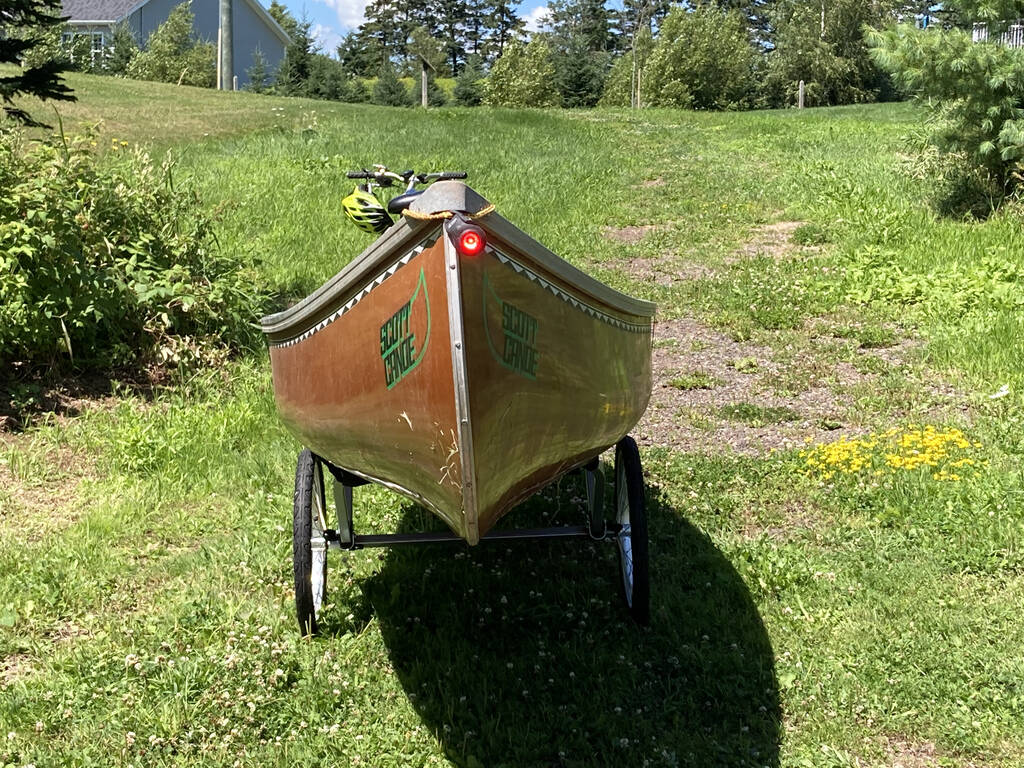
Cycling Home
Cycling home proved to be somewhat more exhausting than cycling out: I was going into the wind, I was tired, and I wore myself out cycling up Herbert Street to Norwood Road, which was a steep incline. I stopped at the KFC to fill up my water bottle (thank you generous staff!), and cycled most of the way home in the lowest gear on my bike.
The only issue I had cycling home otherwise was that I didn’t make a r-e-a-l-l-y w-i-d-e t-u-r-n at the intersection of Murchison Lane at Riverside: the canoe grazed a light pole, and the knot connecting it to the bicycle hitch (helpfully) let go, leaving it behind me. No harm no foul: I hitched things back up and was on my way quickly.
It took me 30 minutes to cycle from home out to Andrews Pond; I was in the water for an hour; it took me 45 minutes to cycle home. I don’t think I’ve been as tired–or as happy–in a long time as when I cycled back into my own driveway. A driveway that, conveniently, has just enough space to fit a canoe between my car and the neighbour’s garbage bins:
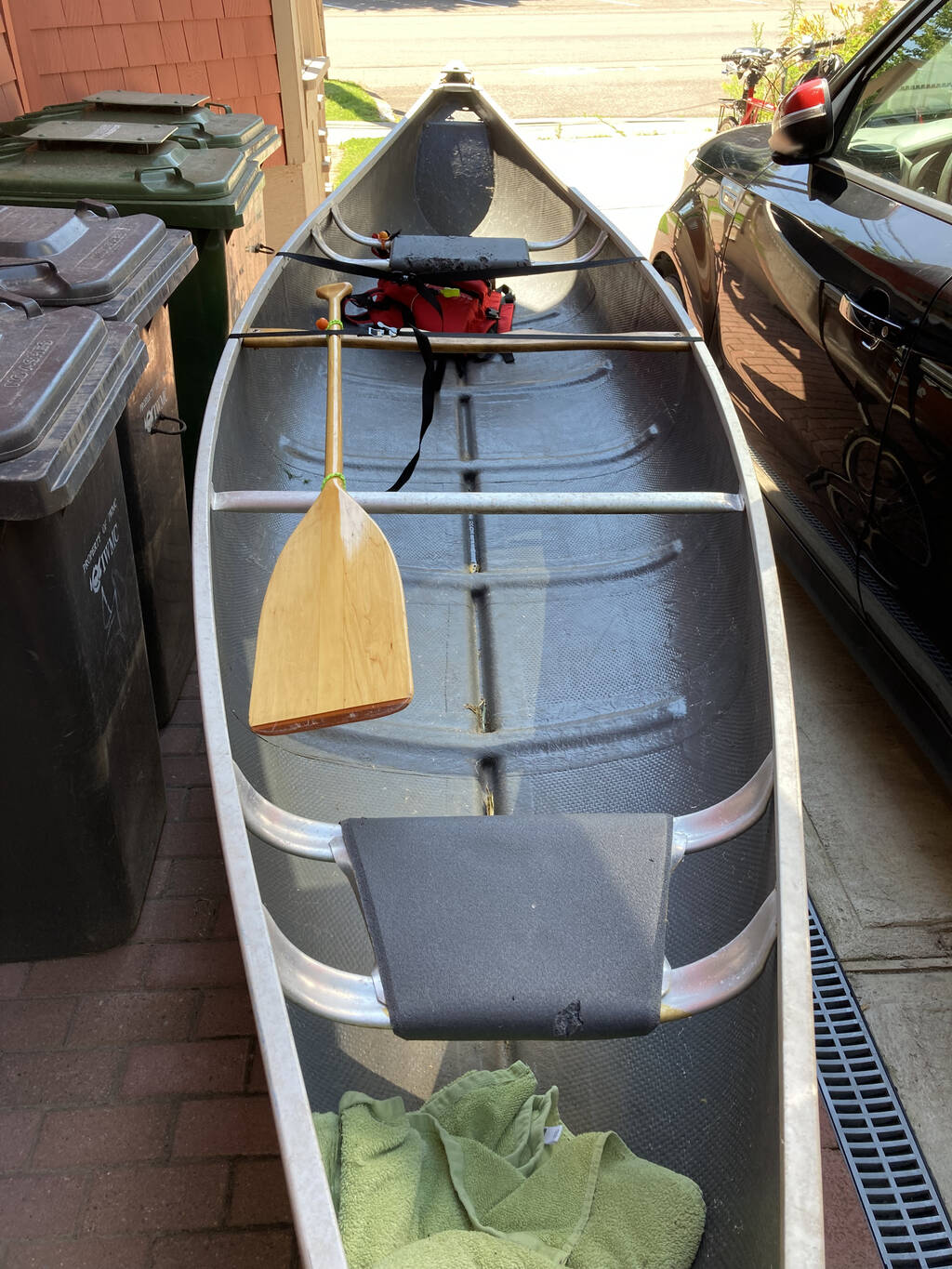
What I Learned
I learned a bunch of things:
- I discovered is that the almost-universal reaction from others when encountering a man towing a canoe with a bicycle is a broad smile on their face, often accompanied by a thumbs up or, from passing cars, a honk of the horn.
- I’m physically more capable than I thought. Two years ago I wouldn’t have been able to cycle out to Andrews Pond without a canoe behind me; all the cycling I’ve done since, with trailers and without, has made me stronger. That feels good.
- It’s very satisfying to do things that exist on the edge of what I think possible.
- It’s very satisfying to do things that require planning: I am, by default, a one-day-build kind of person, and so to get my canoe out of the shed, get it repaired, order a trailer, figure out how it worked, find a place to canoe, etc., was atypically conducted over a month.
- Nature that’s nearby is more interesting to me than nature that’s more “natural” but farther away: I like the fact, a lot, that Andrews Pond is in the city, that I can cycle there in 30 minutes, that it’s “part of where I live” as opposed to “a place I go to get away from where I live.”
- All hail John Andrew for his Herculean effort to preserve and protect the Watershed his family has called home for generations.
Here’s my entire route, from home to pond and back:
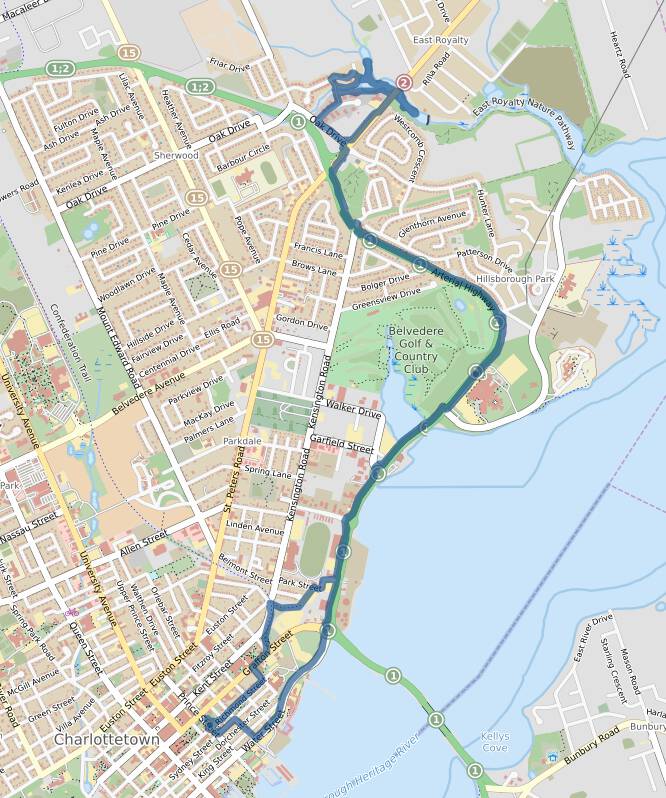
And here’s my route around the pond:
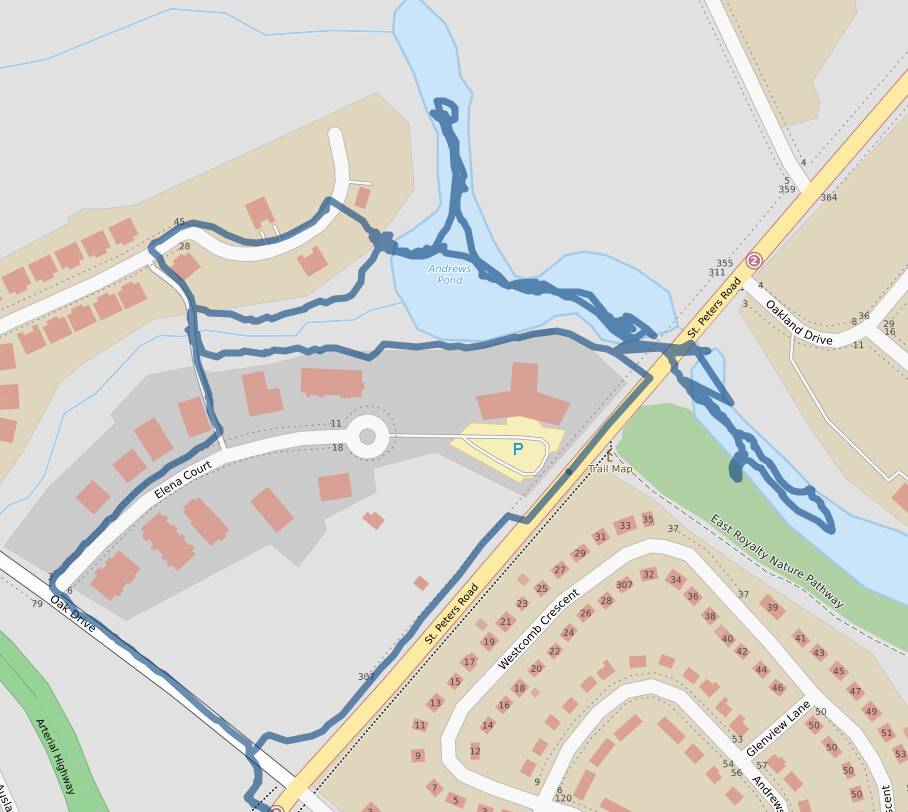
I am an unrepentant fan of the BBC’s Kermode & Mayo Film Review program. I have been listening to the weekly Friday podcast for as long as there have been podcasts.
During COVID times, with the film tap slowed to a dribble, the show conjured up various ways of discussing films without many new films to discuss; one such diversion was to solicit recommendations from the listenership for films best representing the states and provinces of the US and Canada.
Each week a new region was solicited for, and this week it was the 902’s chance to shine, with an invitation for films from Prince Edward Island and Nova Scotia.
There was clearly no way I wasn’t going to send something in. My initial inclination was Rebecca Miller’s The Ballad of Jack and Rose. While the film was indeed made here, in Rock Barra, and employed many Islanders, it isn’t really a film about PEI.
A film that is about PEI, perhaps more so than any film ever made, however, is Alexis Bulman and Patrick Callbeck’s Rainbow Valley. So that was my nominee.
Listening to the episode tonight, there it was, read out across the sea!
As we were also invited to provide a culinary taste of our province, I took the opportunity to avoid the stereotypical and instead mentioned our excellent Lebanese food, which rarely gets the attention it deserves.
I’m hopeful that at least a few new people find their way to Patrick and Alexis’ film: it really is a gem.
 ,
, 
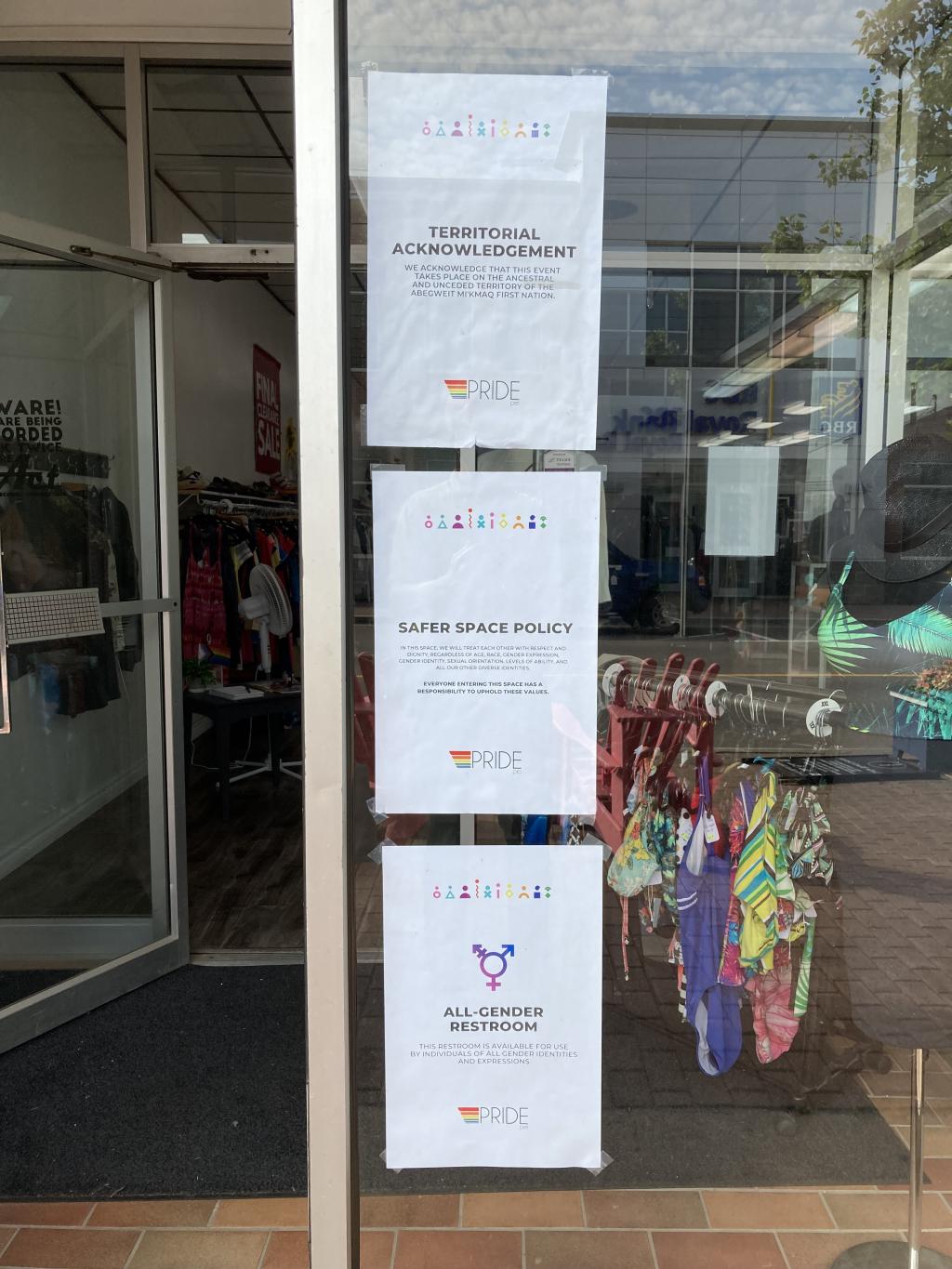
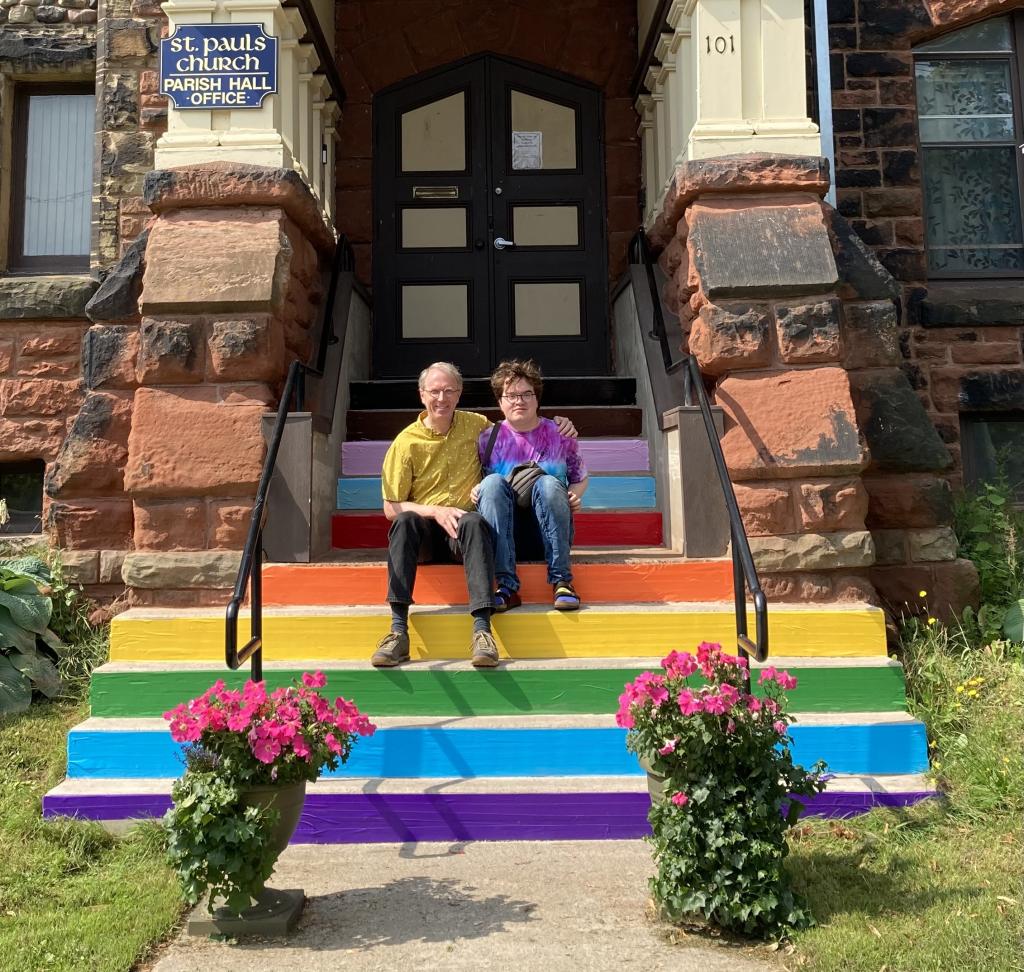
 I am
I am